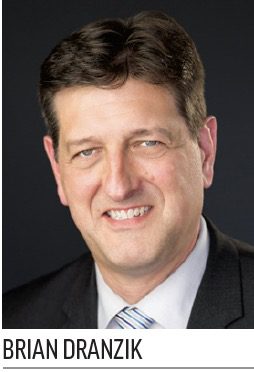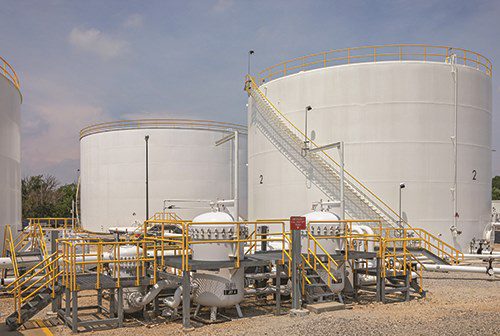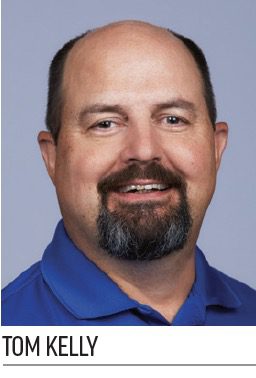For decades, Milwaukee General Mitchell International Airport (MKE) received its jet fuel from an off-airport Shell storage facility supplied by a pipeline running from Chicago-area refineries up the western shore of Lake Michigan through Milwaukee to Green Bay, WI. But in 2016, the pipeline operator decided to decommission the segment of pipeline north of Milwaukee, and Shell consequently announced plans to sell the facility that supplied all of MKE’s jet fuel.
For decades, Milwaukee General Mitchell International Airport (MKE) received its jet fuel from an off-airport Shell storage facility supplied by a pipeline running from Chicago-area refineries up the western shore of Lake Michigan through Milwaukee to Green Bay, WI. But in 2016, the pipeline operator decided to decommission the segment of pipeline north of Milwaukee, and Shell consequently announced plans to sell the facility that supplied all of MKE’s jet fuel.
 Suddenly, it became essential to rethink fueling operations for the county-owned airport. The solution, dubbed the Direct Feed Project, included a modernized fuel hydrant system for the airlines, removing the underground storage tanks at the on-airport facility, installing a new pumping facility and a new two-position island for over-the-road transport trucks loading and unloading jet fuel at the off-airport bulk storage facility.
Suddenly, it became essential to rethink fueling operations for the county-owned airport. The solution, dubbed the Direct Feed Project, included a modernized fuel hydrant system for the airlines, removing the underground storage tanks at the on-airport facility, installing a new pumping facility and a new two-position island for over-the-road transport trucks loading and unloading jet fuel at the off-airport bulk storage facility.
After a $25 million investment by the airport’s fueling consortium, MKE now has a more modern and efficient fuel supply system—and the consortium can supply jet fuel to other regional airports to offset its costs.
|
facts&figures Project: Direct Feed Fuel System Location: Milwaukee General Mitchell Int’l Airport Configuration: Off-airport bulk storage & pumping that feeds 3-terminal hydrant system with on-airport truck rack & hydrant cart test stand Approx. Cost: $25 million (including purchase of storage facility) Total System Capacity: 7.9 million gallons Working Capacity: 6.85 million gallons Airport Owner: Milwaukee County System Owner: MKE Fuel Company LLC (airline fueling consortium) Fuel Farm Manager/Operator: Menzies Aviation Construction: April 2019–June 2020 Design & Construction: Burns & McDonnell General Contractor: Burns & McDonnell Sub-contractors: Lunda; AZCO; Pieper Power Hydrant Pump Manufacturer: Goulds Pumps Tank Gauging System: Honeywell Servo; Temp Probe Electrical Contractor: Eaton VFDs Generator: Caterpillar 1000KW Of Note: Decommissioning of Shell pipeline & nearby storage facility prompted fuel consortium to re-engineer MKE’s fuel system; new system supplies MKE & other regional airports. |
“This upgraded fuel facility support4s the safe and efficient flow of fuel to airports across the region,” says MKE Airport Director Brian Dranzik. “I’m pleased our airline partners at MKE are making this investment to support future growth.”
Real Estate Purchase
When Shell decided to sell its storage facility near MKE, that prompted the airport’s fuel consortium to purchase the facility because on-site storage capacity at MKE was small—just two 40,000-gallon underground tanks for an airport that served seven major airlines and 7 million passengers last year.
Southwest Airlines is one of the airport’s key carriers and fuel consortium members. Tom Kelly, associate fuel category manager for Southwest and MKE fuel consortium chairman, explains that MKE got by with its previous fuel system by replenishing the on-airport tanks with Jet-A from Shell’s nearby storage facility several times a day. It was a workable solution, but not a sustainable one.
“When we heard Shell was going to sell the facility, we didn’t know who was going to own it or what was going to happen to it,” Kelly recalls.” But we did know that if someone else decided to turn it into a diesel facility, Milwaukee [International] would really be in a bad way.”
In early 2017, when it became apparent that MKE’s fuel supply was at risk, the fuel consortium committee formed a limited liability corporation, secured financing and entered negotiations with Shell to buy its bulk storage facility. The consortium also promptly contracted Burns & McDonnell to lead design, construction and construction management for the project, which was executed in two phases.
First Things First
Even though the fuel consortium had been using the off-airport facility for years, a few surprises emerged once it took ownership. And they weren’t pleasant surprises.
Based on the results of a site inspection/evaluation, the project team’s highest priority was replacing the bottom of one of the aboveground storage tanks. An overall assessment prompted the consortium to work with Burns & McDonnell on a plan for reconfiguring both the on- and off-airport fuel facilities.
But the first order of business was putting a new bottom on the tank, which took about 10 months. Grant Smith, director of Aviation Services at Burns & McDonnell, emphasizes that it was key to address the tank bottom and permitting issues quickly to ensure the long-term use of the facility.
 “The airport was obviously very much involved,” Smith says. “The overall coordination and communication on this project was excellent.” Burns & McDonnell primarily worked with MKE Environmental Manager Greg Failey and Menzies Aviation, which manages and operates the fuel farm.
“The airport was obviously very much involved,” Smith says. “The overall coordination and communication on this project was excellent.” Burns & McDonnell primarily worked with MKE Environmental Manager Greg Failey and Menzies Aviation, which manages and operates the fuel farm.
After engineers further evaluated and assessed the facility, they developed a plan called the Direct Feed Project, so named because the end result was moving pumping capacity to the off-airport facility and converting the on-airport facility into just a hydrant cart test stand and load rack for refueler tanker trucks.
End-to-End Enhancements
Once the tank bottom was secure, it was time to get to the meat of the larger plan Burns & McDonnell had devised.
Phase II focused on installing a new truck loading island at the off-airport facility. To improve vehicle flow, project designers relocated a section of perimeter security fence and access gate, and also moved an emergency generator. The site’s water well was protected with a cover that trucks can drive over.
Modifications to the direct feed bulk facility also led to the installation of a new into-hydrant pumping system. The new system includes three centrifugal pumps with variable frequency drives, filter separators, a backpressure control and recirculation loop, provisions for future leak detection testing, and a new electrical service entrance, emergency generator, programmable logic controls and electrical enclosure.
One of its many high-tech bells and whistles is an automated system that can be operated, maintained and viewed from three different computer screens: one in Menzies’ office, one at the on-airport facility, and another at the off-airport facility. Operators can control and monitor the whole system, perform maintenance and troubleshooting, and remotely address problems.
Smith explains that the new variable frequency drives make the system safer, more efficient and more environmentally sound because they help the pumps run more smoothly. He equates it to using the gas pedal when driving a car. “With the old system, the pumps would just come on full throttle,” he says. “But with a variable frequency drive system, it doesn’t hammer or force on the piping in the system. It makes it much safer and more efficient. We have already seen a 30% to 40% reduction in electric usage.”
When modifying the direct feed airside facility, crews removed existing filter separators, piping, valves, pumps and a 500-gallon waste tank, and closed the two 40,000-gallon underground storage tanks.
A new automatic tank gauging system for all three storage tanks at the bulk storage facility was constructed, along with new remote surveillance at the bulk storage facility that includes display units and a digital video recorder. Crews also replaced the perimeter lighting and added more poles to better illuminate the facility exterior.
Phase II also involved working with the Department of Transportation to designate the existing transfer line from the off-airport facility to the hydrant system from an interstate pipeline to a facility transfer line regulated by the U.S. Environmental Protection Agency and Wisconsin Department of Natural Resources.
In the meantime, airlines at MKE still needed fuel. “Obviously there were still aircraft flying and fuel that needed to be used,” says Smith. “So there was a lot of coordination with Menzies Aviation to make sure they could take the jet fuel in from the West Shore pipeline, handle it properly, and get it to the aircraft in a safe, efficient manner while we were building new facilities right next to the operating facilities.”
Switching to the new pumping system without disrupting service required several overnight sessions. “You go in at night when there is low or no activity and do the transfer over to the new system,” Smith explains. “We had to pressurize it and make sure it all worked and was ready for the 5 a.m. fueling. Sometimes you only have a few hours to be able to do that, so it’s definitely a challenge in planning and coordination.”
Kelly notes that working with MKE staff made that task easier. “In my position, I see and hear a lot of stories about how difficult airports can be to work with,” he remarks. “That was not the case here in Milwaukee. It is a great relationship with the airport staff, who are very accommodating.”

Meeting Regional Demand
One of the factors that prompted Shell to sell its storage facility was that the facility had too much capacity to serve only MKE. The fueling consortium turned that “problem” into an opportunity by installing a two-spot truck rack so it could make fuel from the facility available to other airports.
When the local segment of pipeline was taken out of commission, small airports all over the region lost access to Jet-A. Some were driving south to Des Plaines, IL, or as far north as Minneapolis to pick up fuel. Now, the revamped facility near MKE serves their needs—and the fuel consortium charges a user’s fee to offset the cost of the loading facility infrastructure.
 Kelly notes that the MKE’s airlines are also pleased with the new arrangement. “It’s off-airport and completely owned by the consortium. So we have tremendous freedom to do whatever we need to do at that facility as long as we are still servicing the airport,” he explains. “We are looking forward to being able to provide for the region’s Jet-A needs, and are in negotiations with potential users looking forward to that long-term asset at the facility.”
Kelly notes that the MKE’s airlines are also pleased with the new arrangement. “It’s off-airport and completely owned by the consortium. So we have tremendous freedom to do whatever we need to do at that facility as long as we are still servicing the airport,” he explains. “We are looking forward to being able to provide for the region’s Jet-A needs, and are in negotiations with potential users looking forward to that long-term asset at the facility.”
To accommodate the fuel facility’s new customers, project engineers added new ingress and egress, with paved lanes for transport trucks from the entrance to the exit and automated gates for ease of use.
Not surprisingly, the consortium is excited about the prospects that the facility enhancements provide. “We are left with a great facility here in Milwaukee,” says Kelly. “It’s going to be able to service the airport for a long time, and the truck rack is going to be able to service the overall regional Jet-A market for a long time. We are very pleased with the end result.”
Getting Up to Speed
Smith and Kelly shared a similar takeaway after the recent project: Although new features are generally better, they can also be confusing.
“We realized that with the computer controls and heavy modernization that come with a project like this, a lot of times the way the facility operates is really a question mark to the operators—even though they might be very familiar with the facility and working there for a long time,” Kelly explains.
Typically, a comprehensive operations and maintenance manual solves such issues. But when it came time to assemble one at the end of the project, no one was absolutely clear on how it was going to be written, what it should cover, and what the deliverable really was.
Smith likens turning the new facility over to Menzies with asking an accomplished 737 pilot to fly a new A380.“They’re experienced and familiar with the process, but a brand-new facility can be shocking, especially when it has a tremendous leap in modernization,” he explains. “We need to help them adapt to that…train them on the new systems and get them up to speed.”



